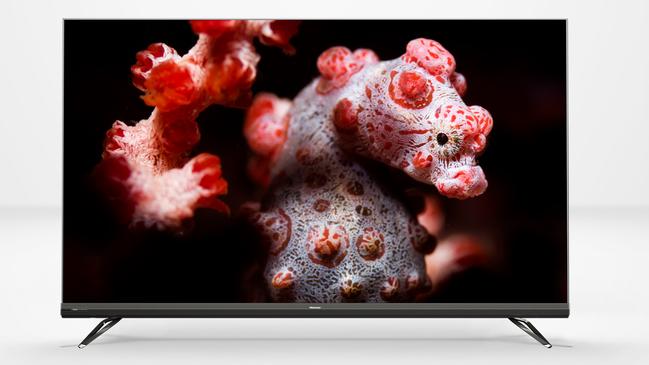Hisense announces “dual cell” TV technology with two LCD panels
Hisense has announced smart TV technology that it says uses two LCD displays to deliver an OLED quality picture.

Hisense has announced a “self raising” laser TV that rolls up in a box beneath the wall when not in use. Given that the company’s laser TV consists of a short throw projector with a projection screen above it, it’s basically a rollable screen.
The self raising laser TV was among announcements of new Hisense smart TVs coming to market in 2020. Many are for the US market only. Some are for the Australian market.
Hisense however will release a “TriChroma” version of its Laser TV into The Australian market. Hisense says the sets produce natural colour from red, green and blue sources, offer less eye strain, and consume half the power of LED TVs of the same size. It says power consumption of its TVs will be reduced by another 30pc in five years.
These Laser TVs will be available with 100, 120 and 150-inch projection displays.
The company will also release Series 4K and 8K TVs in Australia, along with sets making use of its “dual cell technology”, where two LCD displays are moulded together to improve picture quality.
The 2020 range includes the Series Q9 ULED 8K TV and Series Q8 ULED 4K quantum dot TV.
“It’s bigger, better, bolder and pushes the boundaries with game-changing innovations in picture quality, like that offered by our ULED XD,” says Andre Iannuzzi, head of marketing at Hisense Australia. “It’s a range that we’re incredibly proud of.”
The 2020 8K ULED TV has full array backlighting, Dolby Vision and high dynamic range (HDR), managed by the company’s proprietary Hi-View Engine which upscales lower resolution content to 4K and 8K.
The TV has more than two million dimming zone. A dimming zone is an area of the screen that can be individually adjusted. You can alter contrast, colour and brightness of each zone. The rule is that the more zones, the finer the image.
The less expensive series 8 sets also feature HDR and Dolby Vision.
The company also will introduce a 98-inch UHD TV for the first time in 2020.
Hisense is releasing VIDAA 4.0, a new version of the operating system used with its smart TVs. Users can use Amazon Alexa to navigate menus, search and switch apps without needing to attach a third-party device.
The OS will offer more local Australian content such as Netflix, Stan, Amazon Prime Video as well as Freeview Plus for accessing catch-up TV on Australian channels. However Hisense sets don’t support individual catch-up channels.
Lan Lin, chairman of Hisense International, says Hisense global TV sales in 2019 reached more than 20 millions units. He says Hisense was the market leader in China, Australia, South Africa and Japan and its overseas revenue increased more than 20pc in 2019. Its target is to sell 40 million TVs per year.
Hisense also is developing a connected platform to manage other devices at home following several acquisitions including Toshiba, Gorenje and Asko. That will see it compete with Samsung, LG and other TV makers focusing on the connected home.
Hisense says it has been able to create an OLED quality viewing experience by fusing together two LCD panels for its “dual cell” television technology.
“Unlike most conventional LED TVs, the Dual Cell ULED XD uses not one but two LCD layers that are precision-bonded together,” says Hisense. “The first is a greyscale or monochrome layer that controls luminance, while the second layer controls colour.”
Hisense is not the first company to combine monochrome and colour layers; Huawei previously combined monochrome and colour lenses for creating smartphone images, but that’s in a different device. Hisense has applied the concept to TVs.
It says the greyscale layer sits behind the colour layer and effectively blocks light from pixels that need to be darker, creating more than 2 million dimming zones.
The display system uses full array backlighting, which means the lighting of pixels can be controlled with more accuracy than on TVs which light panels from the edges. Sets also feature quantum dot technology and Dolby Vision.
Like all new-age sets, Hisense’s smart TVs have a processor – the Hi-View engine, which adjusts image quality whether it is streamed, sports or cinematic.
National retail training manager Chris Meyer says Hisense has been working on the dual panel technology for five years.
Chris Griffith is attending the Consumer Electronics Show (CES) in Las Vegas courtesy of Hisense Australia.



To join the conversation, please log in. Don't have an account? Register
Join the conversation, you are commenting as Logout